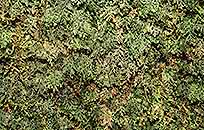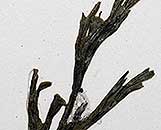Crepidomanes melanotrichum (Schltdl.) J.P. Roux
Synonyms |
Trichomanes melanotrichum Schltdl. |
|---|---|
Common name |
|
Description |
Rhizome filiform, widely creeping, rhizome hairs unbranched, shiny black. Fronds up to 3 cm apart. Stipe 5-35 mm long, winged in upper half, continuing basally as a pronounced rib along which are set 2 rows of black, articulated hairs which frequently break off, leaving a short black stub. Lamina variable, 8-75 × 8-30 mm, 2- or 3-pinnatifid; ultimate lobes narrowly oblong, entire, c. 0.7 mm broad, when dry usually with a vein-like fold between the margin and the vein. Sori obconical, c. 1.5 × 1 mm, narrowly winged for most of their length, valves rounded, entire. |
Notes | Can be confused with C. inopinatum: C. melanotrichum has a stipe that is narrowly winged throughout (only in the upper quarter to half in C. inopinatum) and that has black articulated hairs or leftover stubs (absent or few brown in C. inopinatum). The rhizome hairs are shiny black in C. melanotrichum and dark brown to dull black in C. inopinatum. Can be distinguished from P. borbonicum : P. borbonicum has a stipe that is winged in the distal half to three quarters, has no stipe hairs, the drying fold is absent and rhizome hairs are brown. The sorus is twice as long as wide (as long as wide in C. melanotrichum).
|
Derivation | melanotrichum: black hair; this species has distinctive black rhizome hairs. |
Habitat | Shade in moist forest, on lower part of tree-trunks, moist rock faces, mossy rocks, mossy boulders along stream ; occasionaly in riverine or drier type forest. |
Distribution worldwide | Africa, Madagascar and Mascarenes. |
Distribution in Africa |
Angola, Burundi, Cameroon, Central African Republic, Congo, Dem. Republic of Congo, Equatorial Guinea (incl. Bioko), Ethiopia, Ghana, Guinea, Ivory Coast, Kenya, Lesotho, Liberia, Malawi, Mozambique, Nigeria, Rwanda, Sierra Leone, South Africa, Sudan and South Sudan, Swaziland, Tanzania , Zambia, Zimbabwe. |
Growth form |
Epiphytic, lithophytic. |
Literature |
|


